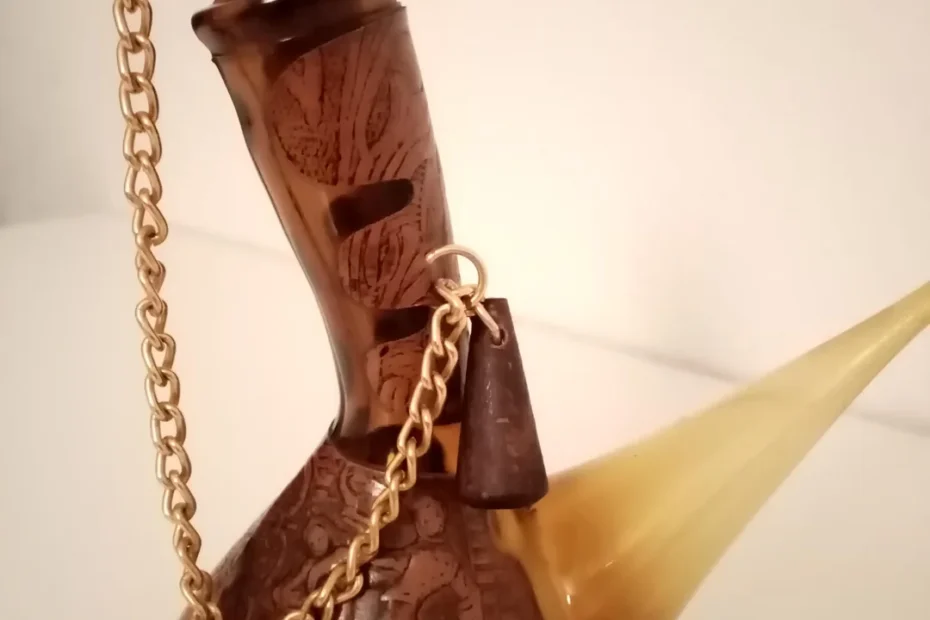A questioner said:
Does anyone know what this is/was used for and what it is called?

Owner also said:
In case it is not obvious: The top is detachable and on the right side there is a really small opening. I’d say it is too small for oil.
Some of the people opinions on it:
Mark Zangs
Looks like a hooka pipe to me.
Emily Fink Bauman
For those who like Ether
Connie Miley Jones
Too bad I can’t see the entire image. What I DO see looks like an oil or vinegar decanter
Werk Reno
Opium pipe?
Ralph Haurin
Bring it over and I’ll show ya
Anthony Gervais
An early 20th century bong?
David Fischer
It is use for drinking wine. We got one in Barcelona Spain. You but the wine in it and pour it from the tip of the cone right in your mouth. The fun part is to see how big of a stream you can make between your mouth and the bottle. It is called a “poron”.
Tyler Anne Stillabower
David Fischer oh yeah! I think you’re right
Mark Boe
Water pipe aka bong
Mary Beth Remisoski
neat handcraft carving ppl pur efforts- now adays ppl tells it is hard work
Anne Croley
A pipe
Kimberly Ruge
Bong.
Brenda Trierweiler
Oil/vinegar container
Robert J Mannino
I could tell you but I’m Christian! Look at the decoration.. hmm okay
Poppie Mike Mac
Oil decanter.
Jeannine Gavalier Hart
My parents had one. They brought it home from Spain when visiting. The spaniel use it for wine.
Carol Taylor
1960s/70s wine
Leanne Turner
I think it’s a baby bottle.
Rose Meeza Cappetta
It’s for wine or olive oil
Tabetha Stephenson
It’s a carafe for oil or wine
Rita Kelly
Botta used to drink wine
Susan Vigilante
I can’t see the whole picture but I’d bet the carving tells the story
Teddi Hauff
Perrone for drinking wine with a special technique
Melissa Jane
Pipe from way back in the good ole days. That top on there seals the pipe
Brian Keith
Bowl !!!! Pack that thing with some good smoke !!!!
Shelley Black
Guessing… oil & vinegar gif salads??
Mark Carleton
Grammy’s bong
What do you think? Let us know in the comment!
Read Also: Does anyone know what this is? It is over the basement door in our 1890’s home.
Have you ever stumbled upon an object whose purpose and name eluded you? Maybe it was found in an old attic, a flea market, or even passed down through generations in your family. Discovering such items can spark curiosity and a desire to uncover their history. Let’s delve into the process of identifying mysterious objects and understanding their uses and names.
Steps to Identify an Unknown Object
Examine Physical Characteristics: Begin by closely examining the object. Note its size, shape, material, any markings or inscriptions, and distinctive features. This initial assessment can provide clues about the object’s era and possible uses.
Contextual Clues: Consider where the object was found. Objects discovered in a kitchen might relate to cooking or food preparation, while those found in a workshop could be tools or parts of machinery.
Functionality: Try to determine how the object might have been used. Look for moving parts, openings, or areas that suggest handling. This can give insight into its practical application.
Photographs and Descriptions: Taking clear photographs from multiple angles and writing a detailed description can be very helpful. These can be shared with experts or online communities for further input.
Research and Resources: Utilize online databases, antique reference books, and museum collections to compare your object with similar items. Websites dedicated to antiques and historical artifacts can be particularly useful.
Consult Experts: Reach out to historians, antique dealers, or museum curators who specialize in the relevant field. They can often provide authoritative insights based on their expertise.
Online Communities: Platforms like Reddit, specialized Facebook groups, and dedicated forums can be valuable resources. Enthusiasts and experts in these communities can often identify objects quickly based on collective knowledge.
Common Types of Mysterious Objects
Antique Tools: Many old tools have specific uses that are no longer common knowledge. Items like apple peelers, butter churns, or blacksmith tongs might puzzle the uninitiated.
Vintage Household Items: Objects used in daily life in past centuries can appear unusual today. Examples include candle snuffers, washboards, and ice tongs.
Historical Medical Instruments: Medical tools from the past can look bizarre and sometimes intimidating. Instruments used in surgery, dentistry, or general practice have evolved significantly.
Agricultural Implements: Farming tools and devices, especially those from the 19th and early 20th centuries, can be hard to identify without a background in agriculture history.
Military Artifacts: Items like trench art, old medals, or specific types of ammunition can be intriguing and are often rich in history.
Example Identification Process
Object Description: You find a small, intricately designed metal object with a hinged lid and a series of tiny holes on one end.
Physical Characteristics: It’s made of brass, approximately three inches long, with decorative engravings.
Context: Found in an old sewing kit.
Functionality: The hinged lid suggests it was meant to open and close frequently, while the holes might indicate it was used to dispense something.
Research: Online searches and antique sewing tool references reveal it matches the description of a needle case from the 19th century.
Consult Experts: A local museum curator confirms it is indeed a Victorian-era needle case.
Conclusion
Identifying mysterious objects is like solving a puzzle. It requires careful observation, research, and sometimes a bit of detective work. Whether it’s a family heirloom, a flea market find, or a curious artifact from your attic, uncovering the story behind an object can be incredibly rewarding. So, the next time you encounter an enigmatic item, take up the challenge to discover its purpose and name—you might just unveil a fascinating piece of history.
